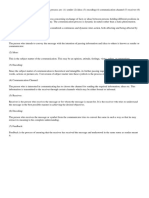0% found this document useful (0 votes)
36 views1 pageQuestions
The document consists of a series of questions related to the communication process, covering topics such as the purpose of communication, components of the communication process, roles of the sender and receiver, types of communication, and barriers to effective communication. It emphasizes the importance of clarity, feedback, and understanding in conveying messages. Additionally, it explores various forms of communication including verbal, written, non-verbal, and digital communication.
Uploaded by
Signor JereCopyright
© © All Rights Reserved
We take content rights seriously. If you suspect this is your content, claim it here.
Available Formats
Download as DOCX, PDF, TXT or read online on Scribd
0% found this document useful (0 votes)
36 views1 pageQuestions
The document consists of a series of questions related to the communication process, covering topics such as the purpose of communication, components of the communication process, roles of the sender and receiver, types of communication, and barriers to effective communication. It emphasizes the importance of clarity, feedback, and understanding in conveying messages. Additionally, it explores various forms of communication including verbal, written, non-verbal, and digital communication.
Uploaded by
Signor JereCopyright
© © All Rights Reserved
We take content rights seriously. If you suspect this is your content, claim it here.
Available Formats
Download as DOCX, PDF, TXT or read online on Scribd
/ 1






























































